Networking Fundamentals Report: Interoperability and Data Transmission
VerifiedAdded on 2020/05/28
|10
|2250
|133
Report
AI Summary
This report delves into the networking fundamentals relevant to an AI company, addressing key concerns such as equipment interoperability. It begins by examining network standards like the OSI, TCP/IP, and DoD models, providing detailed comparisons and diagrams to highlight their differences. T...
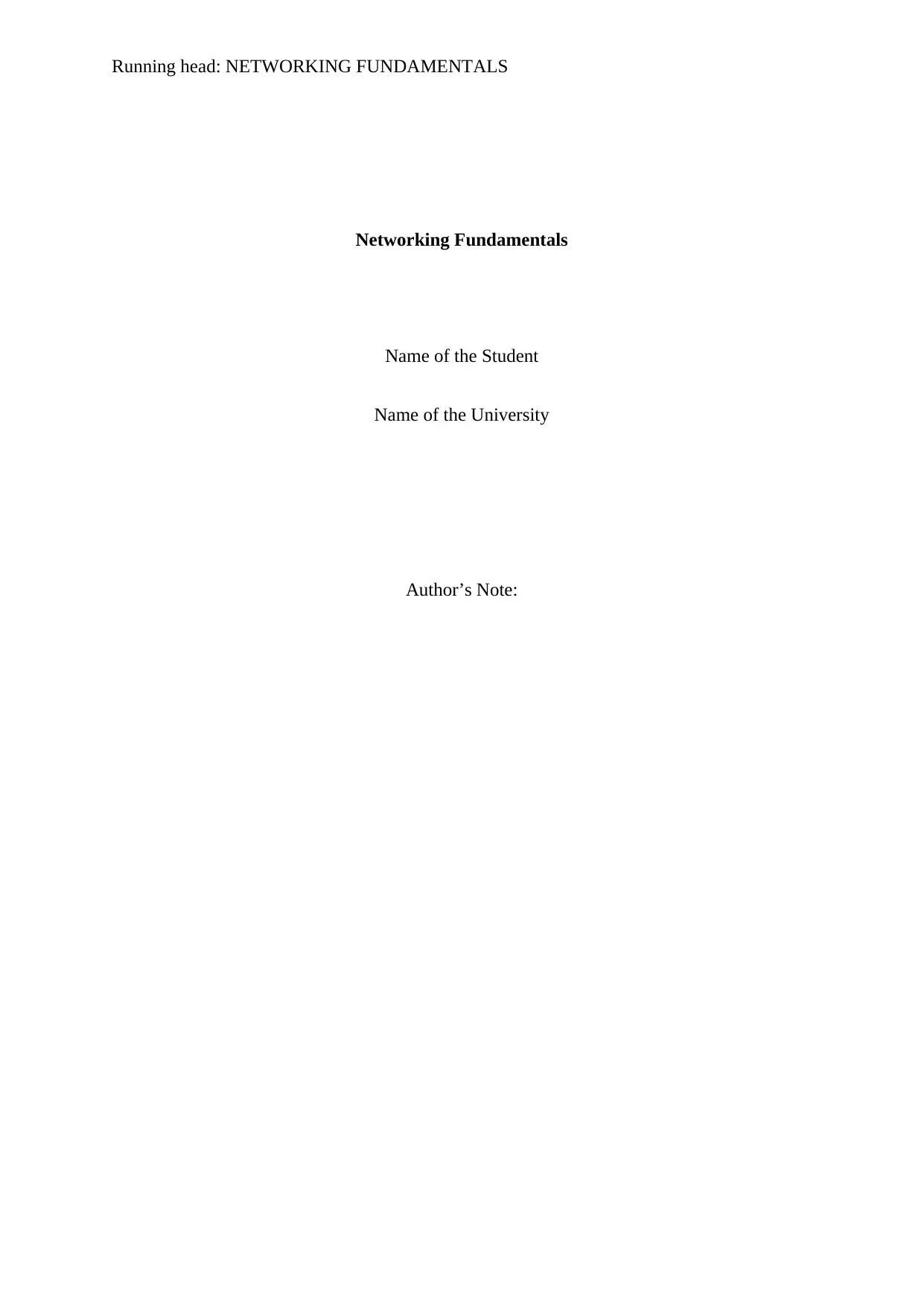
Running head: NETWORKING FUNDAMENTALS
Networking Fundamentals
Name of the Student
Name of the University
Author’s Note:
Networking Fundamentals
Name of the Student
Name of the University
Author’s Note:
Paraphrase This Document
Need a fresh take? Get an instant paraphrase of this document with our AI Paraphraser
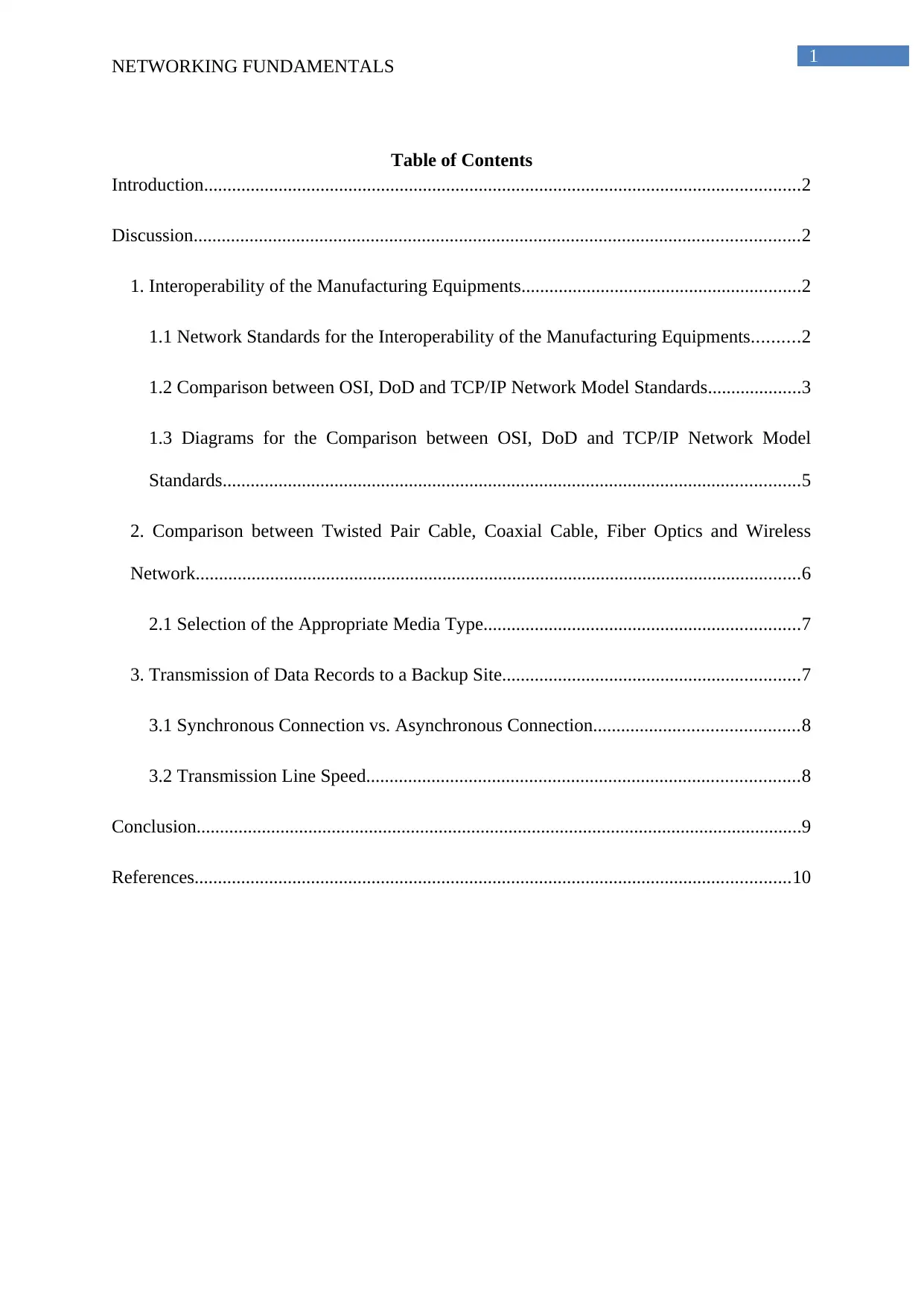
1
NETWORKING FUNDAMENTALS
Table of Contents
Introduction................................................................................................................................2
Discussion..................................................................................................................................2
1. Interoperability of the Manufacturing Equipments............................................................2
1.1 Network Standards for the Interoperability of the Manufacturing Equipments..........2
1.2 Comparison between OSI, DoD and TCP/IP Network Model Standards....................3
1.3 Diagrams for the Comparison between OSI, DoD and TCP/IP Network Model
Standards............................................................................................................................5
2. Comparison between Twisted Pair Cable, Coaxial Cable, Fiber Optics and Wireless
Network..................................................................................................................................6
2.1 Selection of the Appropriate Media Type....................................................................7
3. Transmission of Data Records to a Backup Site................................................................7
3.1 Synchronous Connection vs. Asynchronous Connection............................................8
3.2 Transmission Line Speed.............................................................................................8
Conclusion..................................................................................................................................9
References................................................................................................................................10
NETWORKING FUNDAMENTALS
Table of Contents
Introduction................................................................................................................................2
Discussion..................................................................................................................................2
1. Interoperability of the Manufacturing Equipments............................................................2
1.1 Network Standards for the Interoperability of the Manufacturing Equipments..........2
1.2 Comparison between OSI, DoD and TCP/IP Network Model Standards....................3
1.3 Diagrams for the Comparison between OSI, DoD and TCP/IP Network Model
Standards............................................................................................................................5
2. Comparison between Twisted Pair Cable, Coaxial Cable, Fiber Optics and Wireless
Network..................................................................................................................................6
2.1 Selection of the Appropriate Media Type....................................................................7
3. Transmission of Data Records to a Backup Site................................................................7
3.1 Synchronous Connection vs. Asynchronous Connection............................................8
3.2 Transmission Line Speed.............................................................................................8
Conclusion..................................................................................................................................9
References................................................................................................................................10
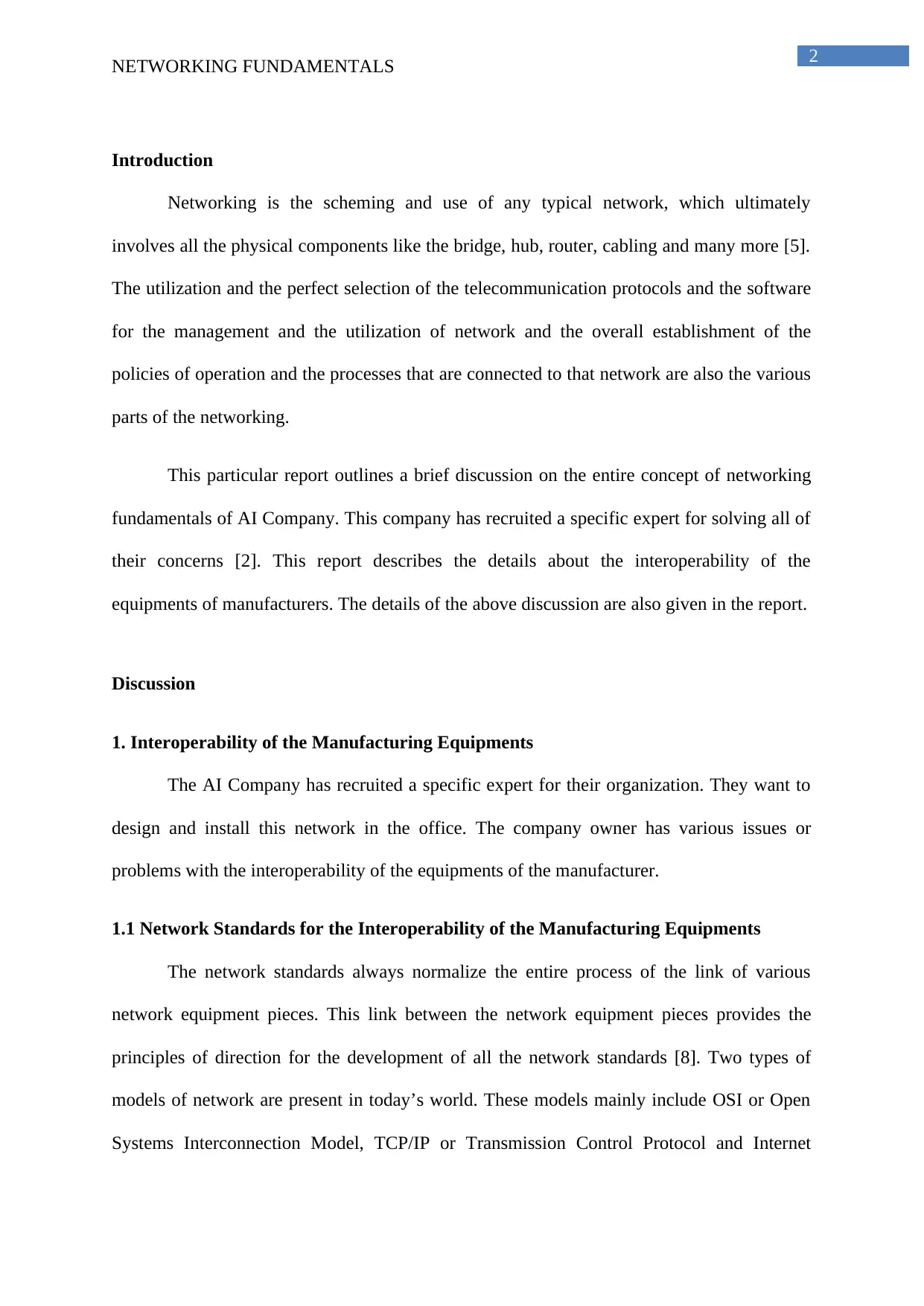
2
NETWORKING FUNDAMENTALS
Introduction
Networking is the scheming and use of any typical network, which ultimately
involves all the physical components like the bridge, hub, router, cabling and many more [5].
The utilization and the perfect selection of the telecommunication protocols and the software
for the management and the utilization of network and the overall establishment of the
policies of operation and the processes that are connected to that network are also the various
parts of the networking.
This particular report outlines a brief discussion on the entire concept of networking
fundamentals of AI Company. This company has recruited a specific expert for solving all of
their concerns [2]. This report describes the details about the interoperability of the
equipments of manufacturers. The details of the above discussion are also given in the report.
Discussion
1. Interoperability of the Manufacturing Equipments
The AI Company has recruited a specific expert for their organization. They want to
design and install this network in the office. The company owner has various issues or
problems with the interoperability of the equipments of the manufacturer.
1.1 Network Standards for the Interoperability of the Manufacturing Equipments
The network standards always normalize the entire process of the link of various
network equipment pieces. This link between the network equipment pieces provides the
principles of direction for the development of all the network standards [8]. Two types of
models of network are present in today’s world. These models mainly include OSI or Open
Systems Interconnection Model, TCP/IP or Transmission Control Protocol and Internet
NETWORKING FUNDAMENTALS
Introduction
Networking is the scheming and use of any typical network, which ultimately
involves all the physical components like the bridge, hub, router, cabling and many more [5].
The utilization and the perfect selection of the telecommunication protocols and the software
for the management and the utilization of network and the overall establishment of the
policies of operation and the processes that are connected to that network are also the various
parts of the networking.
This particular report outlines a brief discussion on the entire concept of networking
fundamentals of AI Company. This company has recruited a specific expert for solving all of
their concerns [2]. This report describes the details about the interoperability of the
equipments of manufacturers. The details of the above discussion are also given in the report.
Discussion
1. Interoperability of the Manufacturing Equipments
The AI Company has recruited a specific expert for their organization. They want to
design and install this network in the office. The company owner has various issues or
problems with the interoperability of the equipments of the manufacturer.
1.1 Network Standards for the Interoperability of the Manufacturing Equipments
The network standards always normalize the entire process of the link of various
network equipment pieces. This link between the network equipment pieces provides the
principles of direction for the development of all the network standards [8]. Two types of
models of network are present in today’s world. These models mainly include OSI or Open
Systems Interconnection Model, TCP/IP or Transmission Control Protocol and Internet
⊘ This is a preview!⊘
Do you want full access?
Subscribe today to unlock all pages.

Trusted by 1+ million students worldwide
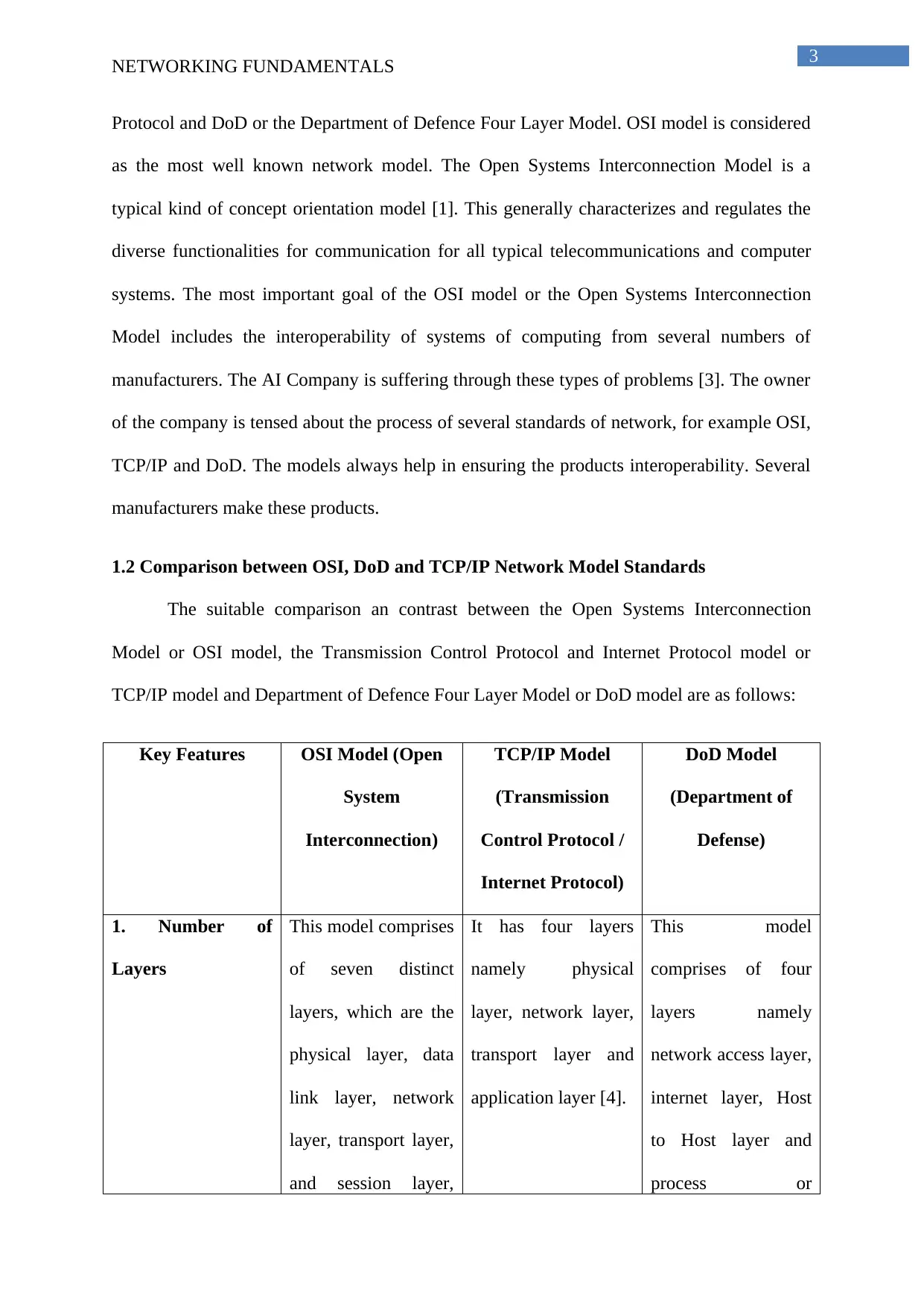
3
NETWORKING FUNDAMENTALS
Protocol and DoD or the Department of Defence Four Layer Model. OSI model is considered
as the most well known network model. The Open Systems Interconnection Model is a
typical kind of concept orientation model [1]. This generally characterizes and regulates the
diverse functionalities for communication for all typical telecommunications and computer
systems. The most important goal of the OSI model or the Open Systems Interconnection
Model includes the interoperability of systems of computing from several numbers of
manufacturers. The AI Company is suffering through these types of problems [3]. The owner
of the company is tensed about the process of several standards of network, for example OSI,
TCP/IP and DoD. The models always help in ensuring the products interoperability. Several
manufacturers make these products.
1.2 Comparison between OSI, DoD and TCP/IP Network Model Standards
The suitable comparison an contrast between the Open Systems Interconnection
Model or OSI model, the Transmission Control Protocol and Internet Protocol model or
TCP/IP model and Department of Defence Four Layer Model or DoD model are as follows:
Key Features OSI Model (Open
System
Interconnection)
TCP/IP Model
(Transmission
Control Protocol /
Internet Protocol)
DoD Model
(Department of
Defense)
1. Number of
Layers
This model comprises
of seven distinct
layers, which are the
physical layer, data
link layer, network
layer, transport layer,
and session layer,
It has four layers
namely physical
layer, network layer,
transport layer and
application layer [4].
This model
comprises of four
layers namely
network access layer,
internet layer, Host
to Host layer and
process or
NETWORKING FUNDAMENTALS
Protocol and DoD or the Department of Defence Four Layer Model. OSI model is considered
as the most well known network model. The Open Systems Interconnection Model is a
typical kind of concept orientation model [1]. This generally characterizes and regulates the
diverse functionalities for communication for all typical telecommunications and computer
systems. The most important goal of the OSI model or the Open Systems Interconnection
Model includes the interoperability of systems of computing from several numbers of
manufacturers. The AI Company is suffering through these types of problems [3]. The owner
of the company is tensed about the process of several standards of network, for example OSI,
TCP/IP and DoD. The models always help in ensuring the products interoperability. Several
manufacturers make these products.
1.2 Comparison between OSI, DoD and TCP/IP Network Model Standards
The suitable comparison an contrast between the Open Systems Interconnection
Model or OSI model, the Transmission Control Protocol and Internet Protocol model or
TCP/IP model and Department of Defence Four Layer Model or DoD model are as follows:
Key Features OSI Model (Open
System
Interconnection)
TCP/IP Model
(Transmission
Control Protocol /
Internet Protocol)
DoD Model
(Department of
Defense)
1. Number of
Layers
This model comprises
of seven distinct
layers, which are the
physical layer, data
link layer, network
layer, transport layer,
and session layer,
It has four layers
namely physical
layer, network layer,
transport layer and
application layer [4].
This model
comprises of four
layers namely
network access layer,
internet layer, Host
to Host layer and
process or
Paraphrase This Document
Need a fresh take? Get an instant paraphrase of this document with our AI Paraphraser

4
NETWORKING FUNDAMENTALS
presentation layer and
application layer
application layer.
2. Approach The approach that is
followed by the OSI
Model is vertical.
The approach that is
followed by the
TCP/IP Model is
horizontal.
The approach that is
followed by the DoD
Model is vertical.
3. Definition The model of OSI is
absolutely perception
oriented, lacking
dependency of
protocol network
standard, which acts
because of the
communication
entrance linking the
network and the user.
The model of TCP/IP
is entirely based on
the different kinds of
typical protocols
wherever the
connectivity is
developed [7]. This
model is not anything
except a protocol of
communication,
which permits the
connection of hosts
in any particular
network.
The model of DoD is
a specific four
layered model, which
comprises of basic
protocols that are
involved with it.
4. Presentation and
Session Layer
Separate presentation
layer and session
layer are present in
the model of OSI.
Separate presentation
layer and session
layer are absent in
the model of TCP/IP.
Separate presentation
layer and session
layer are absent in
the model of DoD. In
fact the presentation
NETWORKING FUNDAMENTALS
presentation layer and
application layer
application layer.
2. Approach The approach that is
followed by the OSI
Model is vertical.
The approach that is
followed by the
TCP/IP Model is
horizontal.
The approach that is
followed by the DoD
Model is vertical.
3. Definition The model of OSI is
absolutely perception
oriented, lacking
dependency of
protocol network
standard, which acts
because of the
communication
entrance linking the
network and the user.
The model of TCP/IP
is entirely based on
the different kinds of
typical protocols
wherever the
connectivity is
developed [7]. This
model is not anything
except a protocol of
communication,
which permits the
connection of hosts
in any particular
network.
The model of DoD is
a specific four
layered model, which
comprises of basic
protocols that are
involved with it.
4. Presentation and
Session Layer
Separate presentation
layer and session
layer are present in
the model of OSI.
Separate presentation
layer and session
layer are absent in
the model of TCP/IP.
Separate presentation
layer and session
layer are absent in
the model of DoD. In
fact the presentation

5
NETWORKING FUNDAMENTALS
and the session
layers are already
present within the
process layer or the
application layer [1].
5. Connections Service is
connection-less.
Service is
connection-oriented
Service is
connection-less.
1.3 Diagrams for the Comparison between OSI, DoD and TCP/IP Network Model
Standards
The diagrams for the comparison between the Open Systems Interconnection Model
or OSI model, the Transmission Control Protocol and Internet Protocol model or TCP/IP
model and Department of Defence Four Layer Model or DoD model are as follows:
Figure 1: Diagrams for the Comparison between OSI and TCP/IP models
NETWORKING FUNDAMENTALS
and the session
layers are already
present within the
process layer or the
application layer [1].
5. Connections Service is
connection-less.
Service is
connection-oriented
Service is
connection-less.
1.3 Diagrams for the Comparison between OSI, DoD and TCP/IP Network Model
Standards
The diagrams for the comparison between the Open Systems Interconnection Model
or OSI model, the Transmission Control Protocol and Internet Protocol model or TCP/IP
model and Department of Defence Four Layer Model or DoD model are as follows:
Figure 1: Diagrams for the Comparison between OSI and TCP/IP models
⊘ This is a preview!⊘
Do you want full access?
Subscribe today to unlock all pages.

Trusted by 1+ million students worldwide
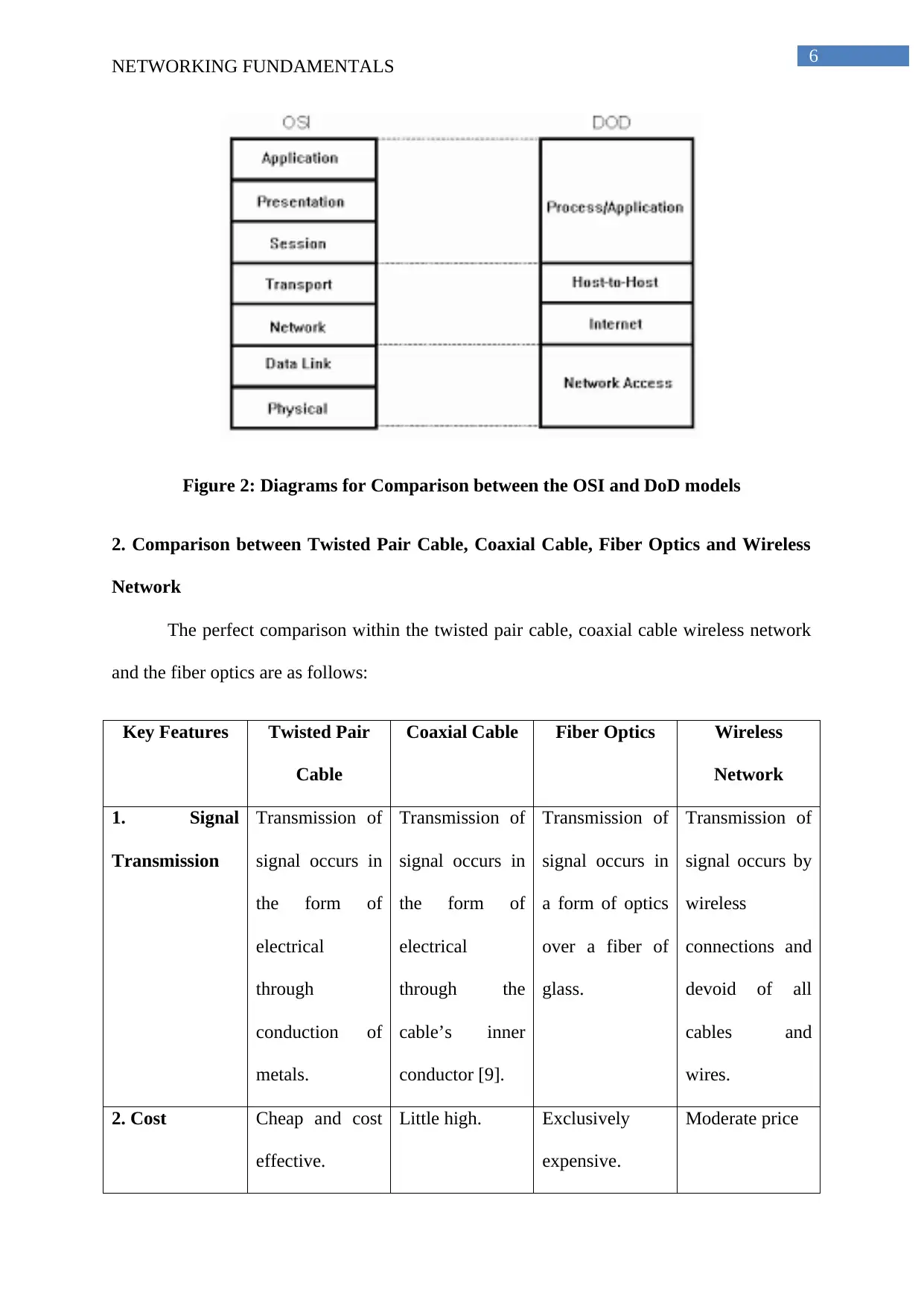
6
NETWORKING FUNDAMENTALS
Figure 2: Diagrams for Comparison between the OSI and DoD models
2. Comparison between Twisted Pair Cable, Coaxial Cable, Fiber Optics and Wireless
Network
The perfect comparison within the twisted pair cable, coaxial cable wireless network
and the fiber optics are as follows:
Key Features Twisted Pair
Cable
Coaxial Cable Fiber Optics Wireless
Network
1. Signal
Transmission
Transmission of
signal occurs in
the form of
electrical
through
conduction of
metals.
Transmission of
signal occurs in
the form of
electrical
through the
cable’s inner
conductor [9].
Transmission of
signal occurs in
a form of optics
over a fiber of
glass.
Transmission of
signal occurs by
wireless
connections and
devoid of all
cables and
wires.
2. Cost Cheap and cost
effective.
Little high. Exclusively
expensive.
Moderate price
NETWORKING FUNDAMENTALS
Figure 2: Diagrams for Comparison between the OSI and DoD models
2. Comparison between Twisted Pair Cable, Coaxial Cable, Fiber Optics and Wireless
Network
The perfect comparison within the twisted pair cable, coaxial cable wireless network
and the fiber optics are as follows:
Key Features Twisted Pair
Cable
Coaxial Cable Fiber Optics Wireless
Network
1. Signal
Transmission
Transmission of
signal occurs in
the form of
electrical
through
conduction of
metals.
Transmission of
signal occurs in
the form of
electrical
through the
cable’s inner
conductor [9].
Transmission of
signal occurs in
a form of optics
over a fiber of
glass.
Transmission of
signal occurs by
wireless
connections and
devoid of all
cables and
wires.
2. Cost Cheap and cost
effective.
Little high. Exclusively
expensive.
Moderate price
Paraphrase This Document
Need a fresh take? Get an instant paraphrase of this document with our AI Paraphraser
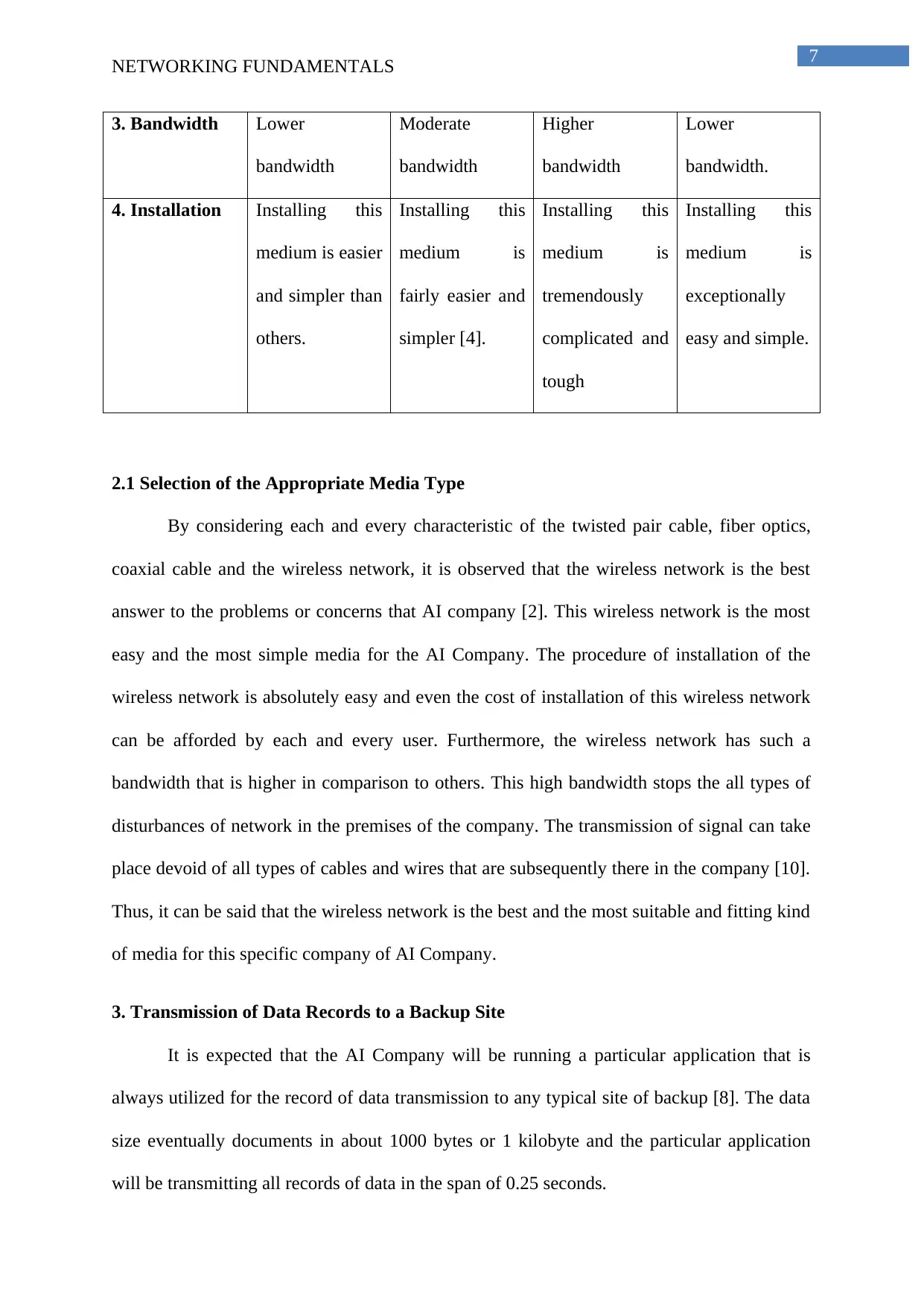
7
NETWORKING FUNDAMENTALS
3. Bandwidth Lower
bandwidth
Moderate
bandwidth
Higher
bandwidth
Lower
bandwidth.
4. Installation Installing this
medium is easier
and simpler than
others.
Installing this
medium is
fairly easier and
simpler [4].
Installing this
medium is
tremendously
complicated and
tough
Installing this
medium is
exceptionally
easy and simple.
2.1 Selection of the Appropriate Media Type
By considering each and every characteristic of the twisted pair cable, fiber optics,
coaxial cable and the wireless network, it is observed that the wireless network is the best
answer to the problems or concerns that AI company [2]. This wireless network is the most
easy and the most simple media for the AI Company. The procedure of installation of the
wireless network is absolutely easy and even the cost of installation of this wireless network
can be afforded by each and every user. Furthermore, the wireless network has such a
bandwidth that is higher in comparison to others. This high bandwidth stops the all types of
disturbances of network in the premises of the company. The transmission of signal can take
place devoid of all types of cables and wires that are subsequently there in the company [10].
Thus, it can be said that the wireless network is the best and the most suitable and fitting kind
of media for this specific company of AI Company.
3. Transmission of Data Records to a Backup Site
It is expected that the AI Company will be running a particular application that is
always utilized for the record of data transmission to any typical site of backup [8]. The data
size eventually documents in about 1000 bytes or 1 kilobyte and the particular application
will be transmitting all records of data in the span of 0.25 seconds.
NETWORKING FUNDAMENTALS
3. Bandwidth Lower
bandwidth
Moderate
bandwidth
Higher
bandwidth
Lower
bandwidth.
4. Installation Installing this
medium is easier
and simpler than
others.
Installing this
medium is
fairly easier and
simpler [4].
Installing this
medium is
tremendously
complicated and
tough
Installing this
medium is
exceptionally
easy and simple.
2.1 Selection of the Appropriate Media Type
By considering each and every characteristic of the twisted pair cable, fiber optics,
coaxial cable and the wireless network, it is observed that the wireless network is the best
answer to the problems or concerns that AI company [2]. This wireless network is the most
easy and the most simple media for the AI Company. The procedure of installation of the
wireless network is absolutely easy and even the cost of installation of this wireless network
can be afforded by each and every user. Furthermore, the wireless network has such a
bandwidth that is higher in comparison to others. This high bandwidth stops the all types of
disturbances of network in the premises of the company. The transmission of signal can take
place devoid of all types of cables and wires that are subsequently there in the company [10].
Thus, it can be said that the wireless network is the best and the most suitable and fitting kind
of media for this specific company of AI Company.
3. Transmission of Data Records to a Backup Site
It is expected that the AI Company will be running a particular application that is
always utilized for the record of data transmission to any typical site of backup [8]. The data
size eventually documents in about 1000 bytes or 1 kilobyte and the particular application
will be transmitting all records of data in the span of 0.25 seconds.
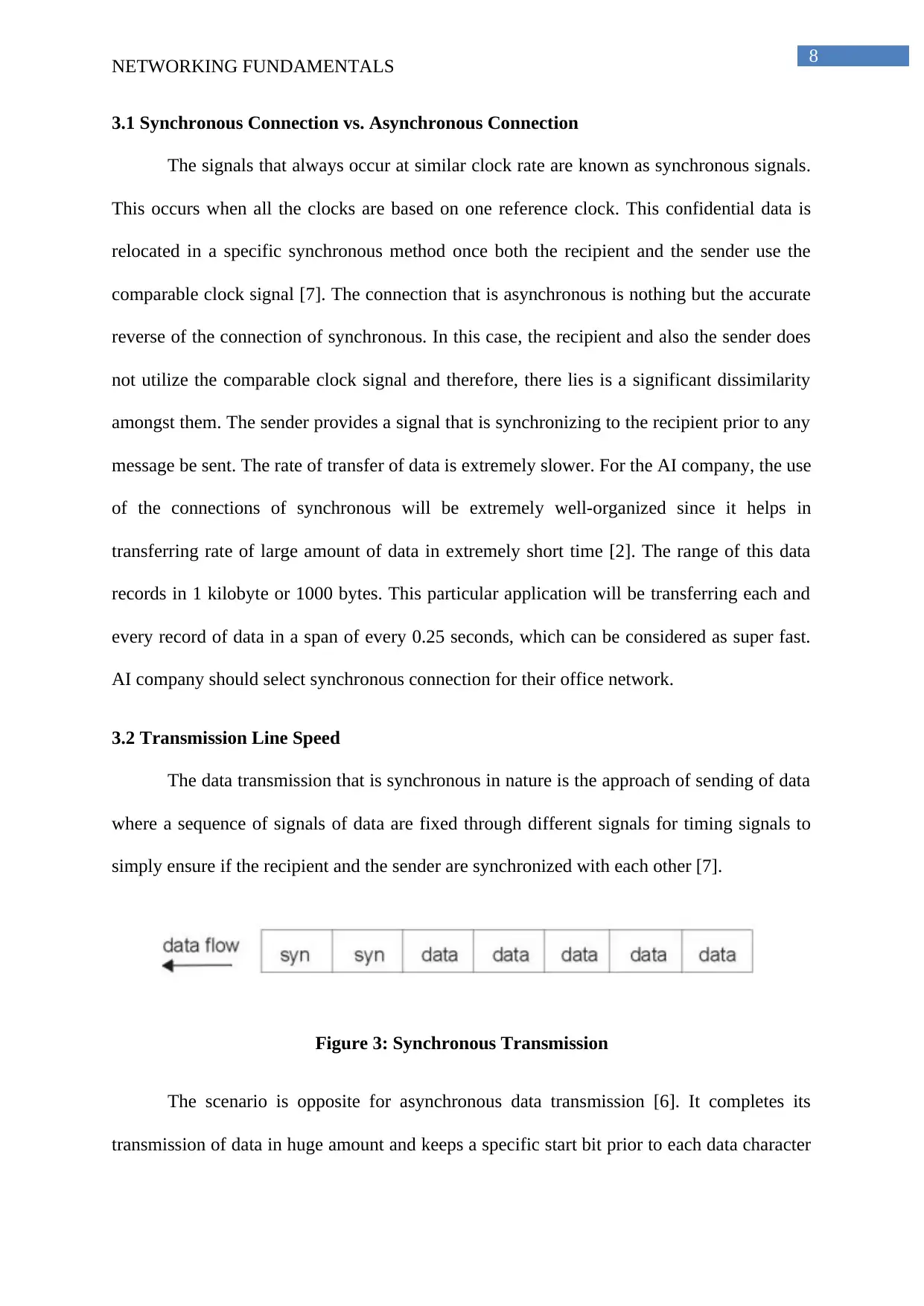
8
NETWORKING FUNDAMENTALS
3.1 Synchronous Connection vs. Asynchronous Connection
The signals that always occur at similar clock rate are known as synchronous signals.
This occurs when all the clocks are based on one reference clock. This confidential data is
relocated in a specific synchronous method once both the recipient and the sender use the
comparable clock signal [7]. The connection that is asynchronous is nothing but the accurate
reverse of the connection of synchronous. In this case, the recipient and also the sender does
not utilize the comparable clock signal and therefore, there lies is a significant dissimilarity
amongst them. The sender provides a signal that is synchronizing to the recipient prior to any
message be sent. The rate of transfer of data is extremely slower. For the AI company, the use
of the connections of synchronous will be extremely well-organized since it helps in
transferring rate of large amount of data in extremely short time [2]. The range of this data
records in 1 kilobyte or 1000 bytes. This particular application will be transferring each and
every record of data in a span of every 0.25 seconds, which can be considered as super fast.
AI company should select synchronous connection for their office network.
3.2 Transmission Line Speed
The data transmission that is synchronous in nature is the approach of sending of data
where a sequence of signals of data are fixed through different signals for timing signals to
simply ensure if the recipient and the sender are synchronized with each other [7].
Figure 3: Synchronous Transmission
The scenario is opposite for asynchronous data transmission [6]. It completes its
transmission of data in huge amount and keeps a specific start bit prior to each data character
NETWORKING FUNDAMENTALS
3.1 Synchronous Connection vs. Asynchronous Connection
The signals that always occur at similar clock rate are known as synchronous signals.
This occurs when all the clocks are based on one reference clock. This confidential data is
relocated in a specific synchronous method once both the recipient and the sender use the
comparable clock signal [7]. The connection that is asynchronous is nothing but the accurate
reverse of the connection of synchronous. In this case, the recipient and also the sender does
not utilize the comparable clock signal and therefore, there lies is a significant dissimilarity
amongst them. The sender provides a signal that is synchronizing to the recipient prior to any
message be sent. The rate of transfer of data is extremely slower. For the AI company, the use
of the connections of synchronous will be extremely well-organized since it helps in
transferring rate of large amount of data in extremely short time [2]. The range of this data
records in 1 kilobyte or 1000 bytes. This particular application will be transferring each and
every record of data in a span of every 0.25 seconds, which can be considered as super fast.
AI company should select synchronous connection for their office network.
3.2 Transmission Line Speed
The data transmission that is synchronous in nature is the approach of sending of data
where a sequence of signals of data are fixed through different signals for timing signals to
simply ensure if the recipient and the sender are synchronized with each other [7].
Figure 3: Synchronous Transmission
The scenario is opposite for asynchronous data transmission [6]. It completes its
transmission of data in huge amount and keeps a specific start bit prior to each data character
⊘ This is a preview!⊘
Do you want full access?
Subscribe today to unlock all pages.

Trusted by 1+ million students worldwide
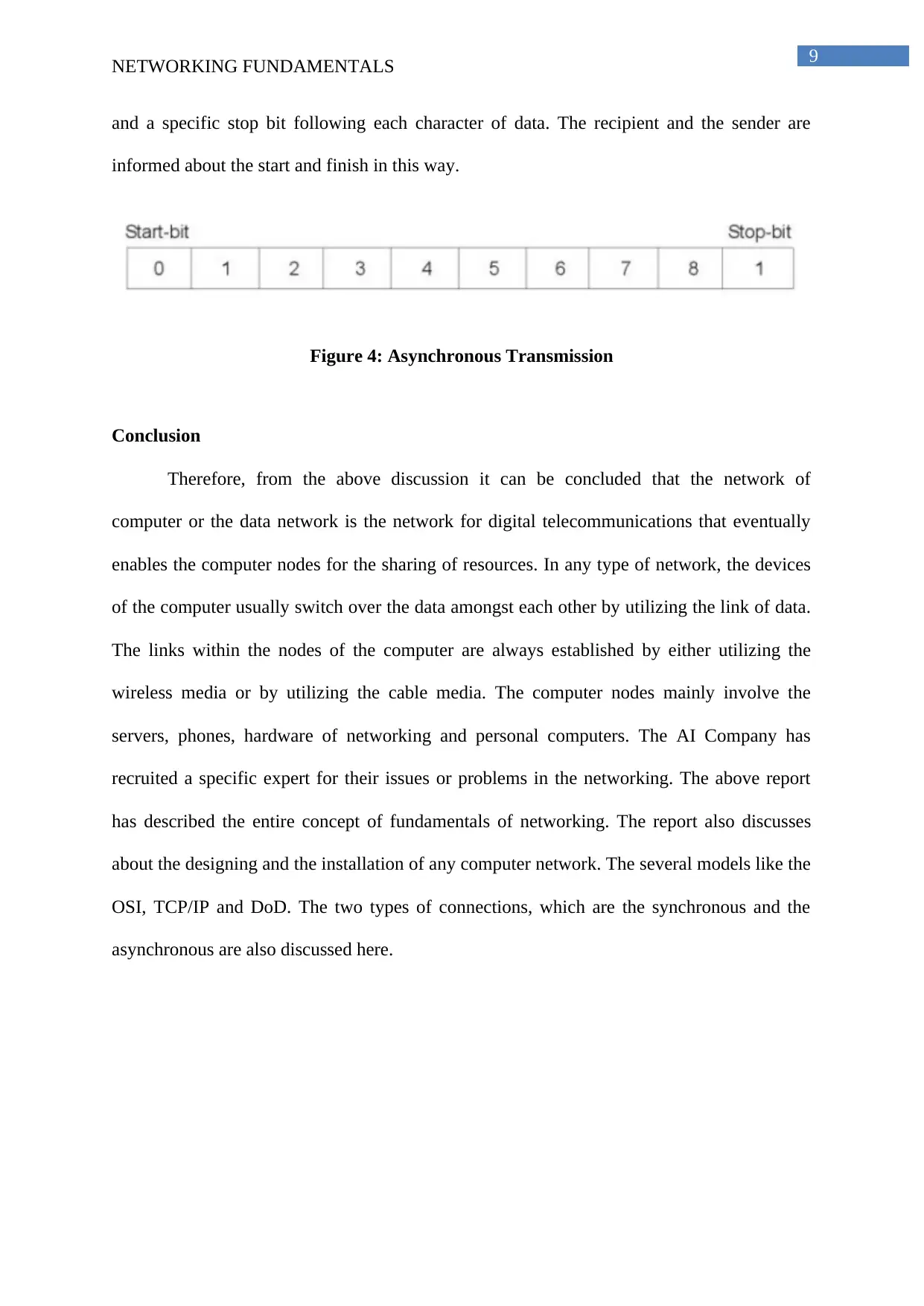
9
NETWORKING FUNDAMENTALS
and a specific stop bit following each character of data. The recipient and the sender are
informed about the start and finish in this way.
Figure 4: Asynchronous Transmission
Conclusion
Therefore, from the above discussion it can be concluded that the network of
computer or the data network is the network for digital telecommunications that eventually
enables the computer nodes for the sharing of resources. In any type of network, the devices
of the computer usually switch over the data amongst each other by utilizing the link of data.
The links within the nodes of the computer are always established by either utilizing the
wireless media or by utilizing the cable media. The computer nodes mainly involve the
servers, phones, hardware of networking and personal computers. The AI Company has
recruited a specific expert for their issues or problems in the networking. The above report
has described the entire concept of fundamentals of networking. The report also discusses
about the designing and the installation of any computer network. The several models like the
OSI, TCP/IP and DoD. The two types of connections, which are the synchronous and the
asynchronous are also discussed here.
NETWORKING FUNDAMENTALS
and a specific stop bit following each character of data. The recipient and the sender are
informed about the start and finish in this way.
Figure 4: Asynchronous Transmission
Conclusion
Therefore, from the above discussion it can be concluded that the network of
computer or the data network is the network for digital telecommunications that eventually
enables the computer nodes for the sharing of resources. In any type of network, the devices
of the computer usually switch over the data amongst each other by utilizing the link of data.
The links within the nodes of the computer are always established by either utilizing the
wireless media or by utilizing the cable media. The computer nodes mainly involve the
servers, phones, hardware of networking and personal computers. The AI Company has
recruited a specific expert for their issues or problems in the networking. The above report
has described the entire concept of fundamentals of networking. The report also discusses
about the designing and the installation of any computer network. The several models like the
OSI, TCP/IP and DoD. The two types of connections, which are the synchronous and the
asynchronous are also discussed here.
1 out of 10
Related Documents
Your All-in-One AI-Powered Toolkit for Academic Success.
+13062052269
info@desklib.com
Available 24*7 on WhatsApp / Email
![[object Object]](/_next/static/media/star-bottom.7253800d.svg)
Unlock your academic potential
© 2024 | Zucol Services PVT LTD | All rights reserved.





